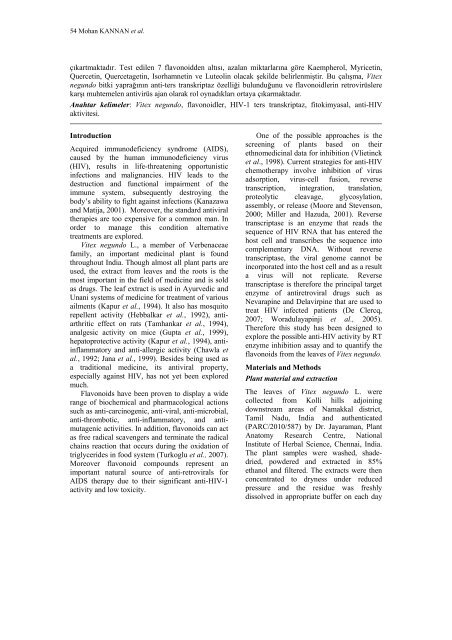10 2 Full Volume (PDF) - Journal of Cell and Molecular Biology ...
10 2 Full Volume (PDF) - Journal of Cell and Molecular Biology ...
10 2 Full Volume (PDF) - Journal of Cell and Molecular Biology ...
You also want an ePaper? Increase the reach of your titles
YUMPU automatically turns print PDFs into web optimized ePapers that Google loves.
54 Mohan KANNAN et al.<br />
çıkartmaktadır. Test edilen 7 flavonoidden altısı, azalan miktarlarına göre Kaempherol, Myricetin,<br />
Quercetin, Quercetagetin, Isorhamnetin ve Luteolin olacak şekilde belirlenmiştir. Bu çalışma, Vitex<br />
negundo bitki yaprağının anti-ters transkriptaz özelliği bulunduğunu ve flavonoidlerin retrovirüslere<br />
karşı muhtemelen antivirüs ajan olarak rol oynadıkları ortaya çıkarmaktadır.<br />
Anahtar kelimeler: Vitex negundo, flavonoidler, HIV-1 ters transkriptaz, fitokimyasal, anti-HIV<br />
aktivitesi.<br />
Introduction<br />
Acquired immunodeficiency syndrome (AIDS),<br />
caused by the human immunodeficiency virus<br />
(HIV), results in life-threatening opportunistic<br />
infections <strong>and</strong> malignancies. HIV leads to the<br />
destruction <strong>and</strong> functional impairment <strong>of</strong> the<br />
immune system, subsequently destroying the<br />
body’s ability to fight against infections (Kanazawa<br />
<strong>and</strong> Matija, 2001). Moreover, the st<strong>and</strong>ard antiviral<br />
therapies are too expensive for a common man. In<br />
order to manage this condition alternative<br />
treatments are explored.<br />
Vitex negundo L., a member <strong>of</strong> Verbenaceae<br />
family, an important medicinal plant is found<br />
throughout India. Though almost all plant parts are<br />
used, the extract from leaves <strong>and</strong> the roots is the<br />
most important in the field <strong>of</strong> medicine <strong>and</strong> is sold<br />
as drugs. The leaf extract is used in Ayurvedic <strong>and</strong><br />
Unani systems <strong>of</strong> medicine for treatment <strong>of</strong> various<br />
ailments (Kapur et al., 1994). It also has mosquito<br />
repellent activity (Hebbalkar et al., 1992), antiarthritic<br />
effect on rats (Tamhankar et al., 1994),<br />
analgesic activity on mice (Gupta et al., 1999),<br />
hepatoprotective activity (Kapur et al., 1994), antiinflammatory<br />
<strong>and</strong> anti-allergic activity (Chawla et<br />
al., 1992; Jana et al., 1999). Besides being used as<br />
a traditional medicine, its antiviral property,<br />
especially against HIV, has not yet been explored<br />
much.<br />
Flavonoids have been proven to display a wide<br />
range <strong>of</strong> biochemical <strong>and</strong> pharmacological actions<br />
such as anti-carcinogenic, anti-viral, anti-microbial,<br />
anti-thrombotic, anti-inflammatory, <strong>and</strong> antimutagenic<br />
activities. In addition, flavonoids can act<br />
as free radical scavengers <strong>and</strong> terminate the radical<br />
chains reaction that occurs during the oxidation <strong>of</strong><br />
triglycerides in food system (Turkoglu et al., 2007).<br />
Moreover flavonoid compounds represent an<br />
important natural source <strong>of</strong> anti-retrovirals for<br />
AIDS therapy due to their significant anti-HIV-1<br />
activity <strong>and</strong> low toxicity.<br />
One <strong>of</strong> the possible approaches is the<br />
screening <strong>of</strong> plants based on their<br />
ethnomedicinal data for inhibition (Vlietinck<br />
et al., 1998). Current strategies for anti-HIV<br />
chemotherapy involve inhibition <strong>of</strong> virus<br />
adsorption, virus-cell fusion, reverse<br />
transcription, integration, translation,<br />
proteolytic cleavage, glycosylation,<br />
assembly, or release (Moore <strong>and</strong> Stevenson,<br />
2000; Miller <strong>and</strong> Hazuda, 2001). Reverse<br />
transcriptase is an enzyme that reads the<br />
sequence <strong>of</strong> HIV RNA that has entered the<br />
host cell <strong>and</strong> transcribes the sequence into<br />
complementary DNA. Without reverse<br />
transcriptase, the viral genome cannot be<br />
incorporated into the host cell <strong>and</strong> as a result<br />
a virus will not replicate. Reverse<br />
transcriptase is therefore the principal target<br />
enzyme <strong>of</strong> antiretroviral drugs such as<br />
Nevarapine <strong>and</strong> Delavirpine that are used to<br />
treat HIV infected patients (De Clercq,<br />
2007; Woradulayapinji et al., 2005).<br />
Therefore this study has been designed to<br />
explore the possible anti-HIV activity by RT<br />
enzyme inhibition assay <strong>and</strong> to quantify the<br />
flavonoids from the leaves <strong>of</strong> Vitex negundo.<br />
Materials <strong>and</strong> Methods<br />
Plant material <strong>and</strong> extraction<br />
The leaves <strong>of</strong> Vitex negundo L. were<br />
collected from Kolli hills adjoining<br />
downstream areas <strong>of</strong> Namakkal district,<br />
Tamil Nadu, India <strong>and</strong> authenticated<br />
(PARC/20<strong>10</strong>/587) by Dr. Jayaraman, Plant<br />
Anatomy Research Centre, National<br />
Institute <strong>of</strong> Herbal Science, Chennai, India.<br />
The plant samples were washed, shadedried,<br />
powdered <strong>and</strong> extracted in 85%<br />
ethanol <strong>and</strong> filtered. The extracts were then<br />
concentrated to dryness under reduced<br />
pressure <strong>and</strong> the residue was freshly<br />
dissolved in appropriate buffer on each day
















